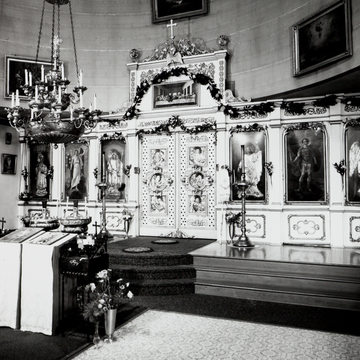As the center of Russian Orthodoxy in Alaska, Saint Michael's Cathedral is appropriately large, prominently placed, and Russian in appearance. Faithfully reconstructed after the 1966 fire, the building was designed originally by Bishop Innocent and completed in 1848. Its cruciform plan, large octagonal dome, and division into elements of sanctuary, nave, and bell tower are hallmarks of Alaskan Russian Orthodox churches.
Before Bishop Innocent arrived in Sitka, he had spent ten years at Unalaska, where he had earned the admiration and respect of the Aleuts, made many converts, and designed and built a church. In 1834 he was assigned to Sitka, where a new church had just been constructed. In 1840, he was consecrated as Bishop Innocent, the first Bishop of Kamchatka, the Kurile and Aleutian Islands. The seat of this bishopric was Sitka, so a cathedral was required. Bishop Innocent designed it himself; the Russian-American Company financed construction. The cornerstone was laid in 1844, and on 20 November 1848, the cathedral was dedicated.
Although the administration of Russian Orthodoxy in Alaska has changed over the years, Sitka has remained the spiritual and administrative center of the church in Alaska, and Saint Michael's Cathedral is its physical embodiment. In 1960–1961, the Historic American Buildings Survey drew the building from measurements taken in the 1940s. It was the first building documented by HABS in the territory. In 1962, Saint Michael's was designated a National Historic Landmark. Just four years later, on 2 January 1966, the cathedral burned to the ground in a fire that destroyed much of downtown Sitka. Although most of the icons were saved, the building was a complete loss. The Russian Orthodox people rallied, however, and the building was reconstructed. The loss of the cathedral even provoked a resurgence of the faith, which had been in decline.
The HABS drawings proved invaluable in the reconstruction of the church. Restoration architect Sergei Padukov of Toms River, New Jersey, adhered to the drawings as closely as possible, substituting fireproof materials for the original log construction. The building measures 67 feet by 97 feet and is in the plan of a Greek cross, with a squarish (15 foot by 18 foot) bell tower on the west end. Originally log, the building is now constructed of steel and concrete, but gray, beaded clapboarding covers the exterior, as it did originally. At the crossing of the gable-roofed nave and transepts, a large octagonal drum, 22 feet in diameter on the interior, supports a copper-clad dome, on top of which is a much smaller cupola and onion dome. The four-story bell tower, with different fenestration at each level, supports an octagonal belfry, on top of which is an attenuated onion dome. The profile of these various domes, rising out of a low mass, is striking and distinctive.
On the interior, there are three altars. The main altar, located in the sanctuary projecting from the rear of the building, is screened by an elaborate seven-bay iconostas. Light is shed on this iconostas from windows in the dome above, which rises nearly 40 feet from the ground, in sharp contrast to the 11-foot height of the rest of the nave. Four Doric columns, as opposed to the original eight, support the ceiling at the base of the dome. The side chapels are located in the transepts, which are open to the nave. In each side chapel, the iconostas is slightly unusual; the paired royal doors are in the center, but the secondary
The interior finish of the cathedral, which consists of linoleum on the floor and sailcloth tacked to the walls, only serves to heighten the beauty of the iconostas and icons. The iconostas is white with gold trim. The gilded royal doors are particularly stunning, and behind them, the altar is a shimmering gold. The main icons on the iconostas are covered with silver rizas. The cathedral's icon collection is particularly rich; two of them depicting Saint Michael the Archangel originally hung in Sitka's first church, constructed in 1816. In addition to those on the iconostas, the cathedral has five exhibit cases of icons. During the fire, all of the icons were rescued, except one depicting the Last Supper, which hung over the royal doors.
Saint Michael's has the air of a big-city cathedral, with tourists constantly strolling in and out and a low hum of activity. The setting is also reminiscent of a metropolitan cathedral, being in the heart of downtown Sitka, with the cathedral dividing Lincoln Street and traffic passing by. Neighboring buildings range from one-story stores to an eight-story apartment building, but Saint Michael's Cathedral has an unmistakable presence and manages to silence them all.






